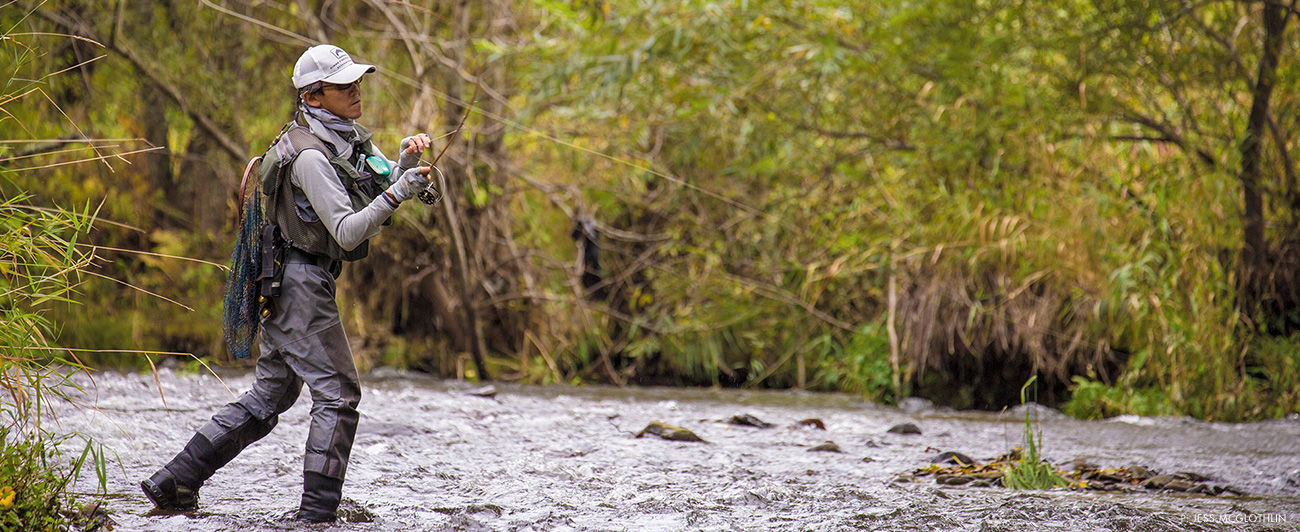Cutbank
A Good Dose of Pantomime
Watching the Water on Hokkaido
Despite the fact that North Korea had recently launched two missiles over the island and a typhoon was barreling our way, the daily tempo of life on Hokkaido appeared peaceful, almost bucolic. Our fall trip to Japan’s northernmost island avoided glaring neon lights and crowded cities. It was only when the scenery was interrupted by a passing military convoy, Japanese letters scrawled tidily on the trucks, that I remembered my location. Convoys crawled the roads, preparing for a possible war with neighboring North Korea.
I’d traveled to Hokkaido to chase fish, regardless of what Kim Jong-un’s missiles or the weather forecast had to say, and met up with Dameon Takada, one of a very small tribe of men who fish Hokkaido. Dameon grew up fishing these waters with his father, and the way he spoke was reflective of his approach on the water: considered, precise and decisive.
We plied the deep, rich waters of Lake Akan for golden char, which take on a particular coloration proudly termed “champagne gold” by locals. Our pursuit of gold, however, had been interrupted by the typhoon. I retreated into one of the myriad mineral hot spring pools, or onsen, at the nearby Akan Yuku no Sato Tsuruga Lodge to ride out the storm.
With the typhoon past, the next day Dameon and his friend, local chef Masaaki Nofuji, took me for a ride. We wove along a rural road, passing convoys as we headed toward a river. Hours into the drive we meandered right at a roadside ice cream and corn vendor then pulled off the road. Dameon and Masaaki stalked toward a wooden bridge, peering into the water below in that seemingly sacred ritual anglers around the world practice: watching the water.
Dense brush and thick vegetation lined the steep banks—including a vine of tiny, wild grapes—and the river was clear enough to watch trout rising in the water column, even with the prior day’s torrential rain. Masaaki watched several rainbows for 15 minutes, gauging their eating patterns and making a plan for a careful approach through the undergrowth. We clambered down the bank and Masaaki patiently worked the fish for two hours. When it became apparent it was not the day for these trout, he climbed back up with a ready smile and a shrug.
Farther down a dirt road we pulled up to a homely hut belonging to a local fishing club. Dameon whipped up bowls of simple ramen while Masaaki and I sat outside, watching clouds scud across the sky as convoys jostled by. He spoke very little English and I speak virtually no Japanese, but thanks to the oddly universal language of flyfishing we could still talk fishing—with a good dose of pantomime. The traditional post-fishing meal and storytelling took on a new flavor as I learned to properly slurp ramen.
“Morning and evening, match the hatch; daytime, terrestrial,” he said. It’s a conversation I’ve had many times over the years, and on six continents now. Fishing supersedes language, and despite speaking exactly four words in Japanese (and I’m pretty sure I mispronounced two of them), it was a companionable conversation.
“They love big fly, this area, these fish,” Masaaki continued between slurps.
Conversation soon shifted to discussion of a pattern that translated as “large-ass caddis” and whether it would be effective in olive. Before we left, we discussed the finer points of testing flies in bathtubs—but never in onsen. Onsen are meant for relaxation, for forgetting about incoming ballistic missiles and typhoons, and not for testing flies.
